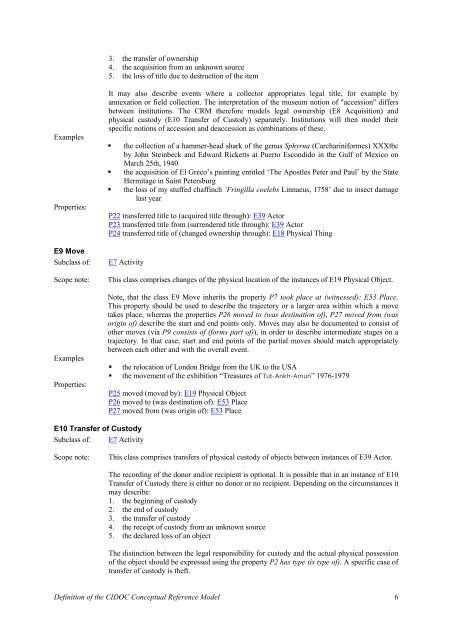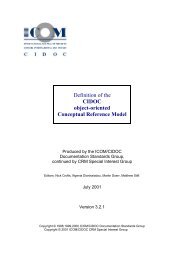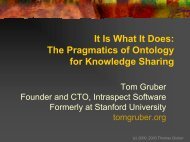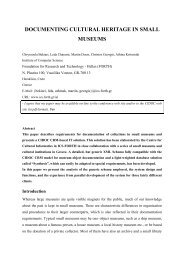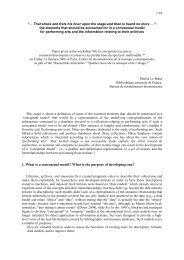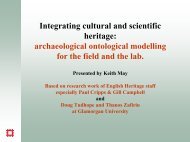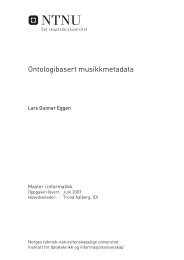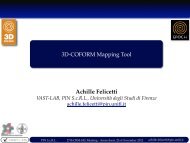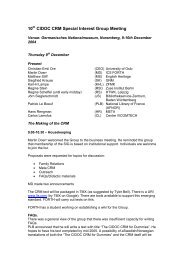pdf file - The CIDOC CRM
pdf file - The CIDOC CRM
pdf file - The CIDOC CRM
Create successful ePaper yourself
Turn your PDF publications into a flip-book with our unique Google optimized e-Paper software.
3. the transfer of ownership<br />
4. the acquisition from an unknown source<br />
5. the loss of title due to destruction of the item<br />
Examples<br />
Properties:<br />
E9 Move<br />
Subclass of:<br />
Scope note:<br />
Examples<br />
Properties:<br />
It may also describe events where a collector appropriates legal title, for example by<br />
annexation or field collection. <strong>The</strong> interpretation of the museum notion of "accession" differs<br />
between institutions. <strong>The</strong> <strong>CRM</strong> therefore models legal ownership (E8 Acquisition) and<br />
physical custody (E10 Transfer of Custody) separately. Institutions will then model their<br />
specific notions of accession and deaccession as combinations of these.<br />
• the collection of a hammer-head shark of the genus Sphyrna (Carchariniformes) XXXtbc<br />
by John Steinbeck and Edward Ricketts at Puerto Escondido in the Gulf of Mexico on<br />
March 25th, 1940<br />
• the acquisition of El Greco’s painting entitled ‘<strong>The</strong> Apostles Peter and Paul’ by the State<br />
Hermitage in Saint Petersburg<br />
• the loss of my stuffed chaffinch ‘Fringilla coelebs Linnaeus, 1758’ due to insect damage<br />
last year<br />
P22 transferred title to (acquired title through): E39 Actor<br />
P23 transferred title from (surrendered title through): E39 Actor<br />
P24 transferred title of (changed ownership through): E18 Physical Thing<br />
E7 Activity<br />
This class comprises changes of the physical location of the instances of E19 Physical Object.<br />
Note, that the class E9 Move inherits the property P7 took place at (witnessed): E53 Place.<br />
This property should be used to describe the trajectory or a larger area within which a move<br />
takes place, whereas the properties P26 moved to (was destination of), P27 moved from (was<br />
origin of) describe the start and end points only. Moves may also be documented to consist of<br />
other moves (via P9 consists of (forms part of)), in order to describe intermediate stages on a<br />
trajectory. In that case, start and end points of the partial moves should match appropriately<br />
between each other and with the overall event.<br />
• the relocation of London Bridge from the UK to the USA<br />
• the movement of the exhibition “Treasures of Tut-Ankh-Amun” 1976-1979<br />
P25 moved (moved by): E19 Physical Object<br />
P26 moved to (was destination of): E53 Place<br />
P27 moved from (was origin of): E53 Place<br />
E10 Transfer of Custody<br />
Subclass of: E7 Activity<br />
Scope note:<br />
This class comprises transfers of physical custody of objects between instances of E39 Actor.<br />
<strong>The</strong> recording of the donor and/or recipient is optional. It is possible that in an instance of E10<br />
Transfer of Custody there is either no donor or no recipient. Depending on the circumstances it<br />
may describe:<br />
1. the beginning of custody<br />
2. the end of custody<br />
3. the transfer of custody<br />
4. the receipt of custody from an unknown source<br />
5. the declared loss of an object<br />
<strong>The</strong> distinction between the legal responsibility for custody and the actual physical possession<br />
of the object should be expressed using the property P2 has type (is type of). A specific case of<br />
transfer of custody is theft.<br />
Definition of the <strong>CIDOC</strong> Conceptual Reference Model 6


